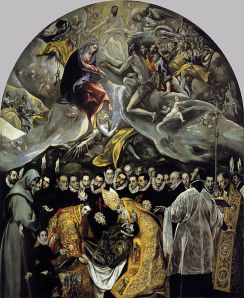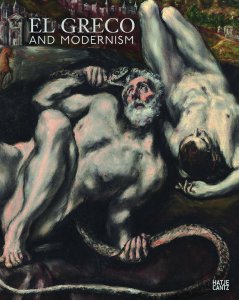 April
07
April
07
Tags
Was El Greco Astigmatic?

The Burial of the Count of Orgaz, 1586-88
On the 7th of April 1614, the famous painter, sculptor and architect of the Spanish Renaissance El Greco, née Doménikos Theotokópoulos, died in Toledo, Spain. Adored by many and criticised by some, during his lifetime he had undergone a long journey starting with Crete, the place of his birth, through Venice, then Rome where he gained significant recognition as a mature painter, arriving finally in Spain. From Madrid, which he was forced to leave due to the lack of recognition from Philip II of Spain, he travelled to Toledo – his final destination. Toledo embraced his talent, and in return he gave the city his absolute best – the most original masterpieces, grand both in scale and artistry. “Toledo, with a population of around sixty thousand, was the seat of the Spanish church and home to powerful churchmen, intellectuals, and potential patrons, many of whom became his friends. The principal themes of Greco’s work – prayer, martyrdom, penitence, salvation, and the intercession of the saints – were also among those of the Spanish Counter-Reformation, whose center was, precisely, Toledo.” (El Greco by David Davies, Review by Ruth MacKay, The Sixteenth Century Journal, Vol. 36, No. 3, Fall, 2005)
 El Greco’s style was highly individual, escaping the fashionable classicist principles concerned with measure, perspective and proportion. He focused instead on conveying grace and atmosphere in his paintings, which he executed in a strongly intuitive manner. El Greco was fascinated by the use of light and colour, highly valuing the latter. “I hold the imitation of colour to be the greatest difficulty of art.”, we learn from his personal notes (Marias-Bustamante, Las Ideas Artisticas de El Greco). “His first commission in Spain (1577) was for altarpieces for the church of Santo Domingo el Antiguo in Toledo (1577-79); the paintings for the high altar show the influence of Titian and Michelangelo. In these works he developed his signature style: he chose a method of space elimination that is common to middle and late 16th-century Italian painters known as Mannerists. The elongated figures in these works were also characteristic of his oeuvre. El Greco’s Mannerist method of composition is nowhere more clearly expressed than in his masterpiece, The Burial of the Count de Orgaz (1586-88), where all of the action takes place in the frontal plane.” (Britannica Concise Encyclopedia)
El Greco’s style was highly individual, escaping the fashionable classicist principles concerned with measure, perspective and proportion. He focused instead on conveying grace and atmosphere in his paintings, which he executed in a strongly intuitive manner. El Greco was fascinated by the use of light and colour, highly valuing the latter. “I hold the imitation of colour to be the greatest difficulty of art.”, we learn from his personal notes (Marias-Bustamante, Las Ideas Artisticas de El Greco). “His first commission in Spain (1577) was for altarpieces for the church of Santo Domingo el Antiguo in Toledo (1577-79); the paintings for the high altar show the influence of Titian and Michelangelo. In these works he developed his signature style: he chose a method of space elimination that is common to middle and late 16th-century Italian painters known as Mannerists. The elongated figures in these works were also characteristic of his oeuvre. El Greco’s Mannerist method of composition is nowhere more clearly expressed than in his masterpiece, The Burial of the Count de Orgaz (1586-88), where all of the action takes place in the frontal plane.” (Britannica Concise Encyclopedia)
Many art historians specialising in El Greco’s work have been trying to decode his predilection for painting elongated figures. One of the proposed theories suggests that the artist could have suffered from an ocular condition called astigmatism. “This is an optical defect of the frontal surface of the eyeball, which if over-corrected by a spectacle lens, could have optically stretched his retinal images horizontally, causing him to paint tall, thin objects that looked normal to him.” (Stuart Anstis, Was El Greco Astigmatic?, Leonardo, Vol. 35, No. 2, 2002). One of the major logical objections, however, is the fact that this kind of defect would have stretched the sitter and the portrait horizontally by the same  amount, and thus both distortions would have cancelled each other out. Consequently, the figures depicted by El Greco should be geometrically accurate. Another argument against this theory was the analysis of his pencil sketches done by the artist prior to covering them with paint. As it turned out, all of the sketches were perfectly proportional. There have also been several laboratory tests done by optical specialists which prove that the tendency to paint tall and thin figures with unproportionally small heads was the artist’s stylistic choice, in keeping with European Mannerism. According to Nicholas Penny, “once in Spain, the artist was able to create a style of his own – one that disavowed most of the descriptive ambitions of painting”. (Nicholas Penny, At the National Gallery)
amount, and thus both distortions would have cancelled each other out. Consequently, the figures depicted by El Greco should be geometrically accurate. Another argument against this theory was the analysis of his pencil sketches done by the artist prior to covering them with paint. As it turned out, all of the sketches were perfectly proportional. There have also been several laboratory tests done by optical specialists which prove that the tendency to paint tall and thin figures with unproportionally small heads was the artist’s stylistic choice, in keeping with European Mannerism. According to Nicholas Penny, “once in Spain, the artist was able to create a style of his own – one that disavowed most of the descriptive ambitions of painting”. (Nicholas Penny, At the National Gallery)
Even though disdained shortly after his death, as his work stood in opposition to the principles of the early Baroque that wiped out the Mannerist tendencies, El Greco was reappraised in the nineteenth century. In fact, his complex and anti-naturalistic style, and unprecedented experimentation with light and colour, has been claimed by some as very much ahead of his time. Therefore, it comes as no surprise that nineteenth-century artists, such as Manet, Cézanne or Picasso, found a source of great inspiration in El Greco’s expressive paintings. It was already clear at the time that El Greco was a genius in his league, not because of his speculated optical defect, but his rare artistic sensitivity and talent. The words that sum this up most aptly are those of Professor of Spanish John Armstrong Crow, who said that “astigmatism could never give quality to a canvas, nor talent to a dunce”. (J.A. Crow, Spain: The Root and the Flower)










The astigmatism theory seems rather nonsensical to me. Astigmatism causes not elongated, but blurred vision. For example, a point-like object is mapped onto two points on the retina (you see it double). Images of neighboring points are mapped ontop of each other. As a result, you see a slightly blurred image. As a result, a pattern of black and white thin stripes appears as a grey surface if turned into the direction of this doubling effect (if you turn it by 90 degrees, you see the stripes). But you don’t see objects as elongated (I am talking here from my own experience) 🙂
LikeLike
He clearly had an issue with his vision or with his precision, its not only matter of artistry. We have here the work of someone who clerly saw things in a different way – I think the elongation is just an exageration for artistic purposes. His sense of dimension was always strange for a man of his talent, I dont think it was all intentional, particularly at a time where dimension was big in terms of precision painting in Europe. His shapes are always slightly off, again not in the way you’d have Gaugin painting in the future.
In any case, not an awful lot of importance dwelling on this I think? I mean we will never know, and it will msot certainly not undermine his work at all, so trying to determine whter he had astigmtism or not seems a bit of a waste of historial resoures and valuable research effort that could be put into finding more like him.
The article was good read though.
LikeLike
El Greco was also very influential on Picasso whose Burial of Casegemas, painted by Picasso following the suicide of his friend Casegemas and which is said to have inspired his Blue period, draws on the Burial of the Count de Orgaz both paintings depicting a heavenly and earthly scene.
LikeLike
Reblogged this on Greek Canadian Literature.
LikeLike